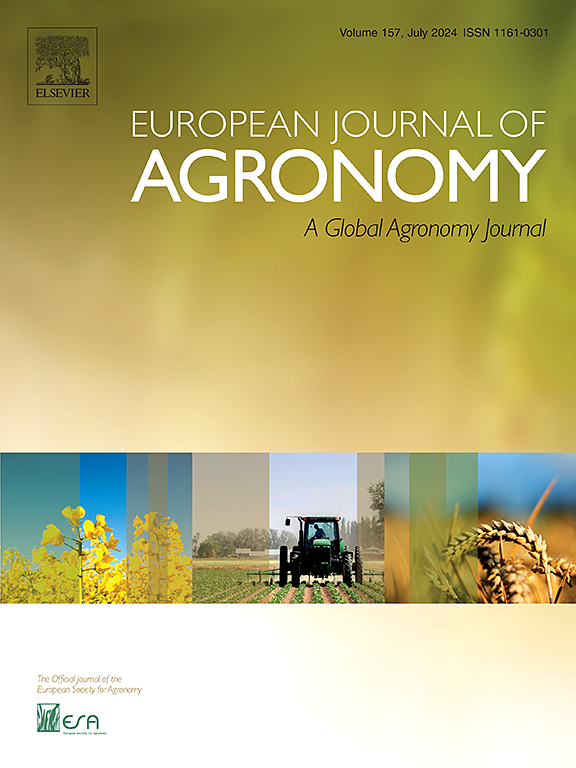土壤传递函数及其对土壤水分动力学模拟和产量预测的影响——以HERMES模型为例
IF 5.5
1区 农林科学
Q1 AGRONOMY
引用次数: 0
摘要
土壤传递函数用于从更容易获得的土壤属性(质地、土壤有机碳)中确定保水参数,可能对土壤水分动力学和作物模型的产量模拟产生重大影响。在本研究中,我们使用HERMES模型,利用由土壤传递函数导出的保水参数(即田间容量、萎蔫点和总孔隙空间),量化和理解了7个土壤传递函数和2个土壤传递函数集合模型对变质地立地作物产量的影响。此外,还建立了连续合成土壤数据库,以评估土壤质地渐变对产量模拟的影响。利用试验点土壤水分测量数据,确定了不同土壤传递函数下土壤水分动力学模拟的准确性。土壤传递函数对产量模拟的影响通过量化试验点和合成土壤数据库间的产量差异来评估。土壤传递函数的选择在大多数情况下导致土壤含水量动态的可测量差异,通常显示出田间容量与含水量之间的直接关系。通常,土壤传递函数产生较高的估算田间容量也导致较高的产量,这表明模型产量模拟对土壤水分有效性敏感。土壤传递函数显示,在合成土壤数据库的含沙率连续体的特定点上,保水性参数估计和产量模拟的变异性越来越大,表明这些函数即使对粒径分布的微小变化也很敏感。本文章由计算机程序翻译,如有差异,请以英文原文为准。
Pedotransfer functions and their impact on soil water dynamics simulation and yield prediction: A HERMES model case study
Pedotransfer functions used to determine water retention parameters from more readily available soil attributes (texture, soil organic carbon) may have a big impact on soil water dynamics and yield simulations by crop models. In this study we used the model HERMES to quantify and understand the impact of seven pedotransfer functions and two pedotransfer function ensemble models on crop yield on sites with variable texture using water retention parameters (i.e. field capacity, wilting point and total pore space) derived from the pedotransfer functions. Additionally, a continuous synthetic soil database was created to assess the effect of gradual changes in soil texture on yield simulation. The accuracy of the soil water dynamics simulations with the different pedotransfer functions was determined using soil water measurements at the test sites. The impact of pedotransfer functions on yield simulations was assessed by quantifying the yield differences at the experimental sites and across the synthetic soil database. The choice of pedotransfer functions resulted in most cases in measurable differences in soil water content dynamics, often showing a direct relationship between field capacity and water content. Often, pedotransfer functions producing higher estimated field capacity also resulted in higher yield, indicating that model yield simulation is sensitive to soil water availability. Pedotransfer functions showed an increasing variability in water retention parameters estimation and yield simulation at specific points in the sand percent continuum of the synthetic soil database, indicating that these functions can be sensitive even to small changes in particle size distribution.
求助全文
通过发布文献求助,成功后即可免费获取论文全文。
去求助
来源期刊

European Journal of Agronomy
农林科学-农艺学
CiteScore
8.30
自引率
7.70%
发文量
187
审稿时长
4.5 months
期刊介绍:
The European Journal of Agronomy, the official journal of the European Society for Agronomy, publishes original research papers reporting experimental and theoretical contributions to field-based agronomy and crop science. The journal will consider research at the field level for agricultural, horticultural and tree crops, that uses comprehensive and explanatory approaches. The EJA covers the following topics:
crop physiology
crop production and management including irrigation, fertilization and soil management
agroclimatology and modelling
plant-soil relationships
crop quality and post-harvest physiology
farming and cropping systems
agroecosystems and the environment
crop-weed interactions and management
organic farming
horticultural crops
papers from the European Society for Agronomy bi-annual meetings
In determining the suitability of submitted articles for publication, particular scrutiny is placed on the degree of novelty and significance of the research and the extent to which it adds to existing knowledge in agronomy.
 求助内容:
求助内容: 应助结果提醒方式:
应助结果提醒方式:


